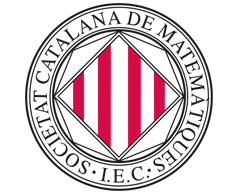Organisers: Roberto Rubio (UAB) and Joana Cirici (UB)
Friday Oct 23, 15:35 – 17:45, Zoom room Pere Coromines
15:35 – 16:15 – Penka Georgieva (IMJ, Sorbonne Université)
In this talk I will give a brief introduction to Gromov-Witten theory and the more recent developments of its real counterpart. These theories involve the study of pseudo-holomorphic curves into a symplectic manifold and have intriguing properties and surprising relations to different domains. I will discuss some of the established results and motivations behind them as time permits.
16:20 – 17:00 – Ben Davison (University of Edinburgh)
Flopping curves are certain contractible copies of the projective line, found in 3-folds. Associated to such a curve is a finite-dimensional algebra, the contraction algebra of Donovan and Wemyss, that represents the noncommutative deformations of the structure sheaf of that curve. A conjecture of Brown and Wemyss states (roughly) that all finite-dimensional Jacobi algebras arise this way. As I’ll explain, this conjecture would imply the positivity of all BPS invariants for finite-dimensional Jacobi algebras – these are invariants defined in terms of the geometry of noncommutative Hilbert schemes. I’ll explain how these are defined, and along the way I will explain why this is a surprising claim by giving examples of negative BPS invariants for infinite-dimensional Jacobi algebras. Finally, I’ll explain that this positivity does indeed hold, providing evidence for the Brown-Wemyss conjecture.
17:05 – 17:45 – Martí Lahoz (Universitat de Barcelona)
Syzygy bundles are the kernel of the evaluation morphism of global sections of a line bundle L. The stability of this vector bundle has been the subject of considerable interest in the case of curves and surfaces because of its applications. In the case of curves, for example, it is used to give conditions on the surjectivity of the natural multiplication map of sections of two vector bundles. And in the case of surfaces with trivial canonical bundle it is also used to control projective normality of the embedding provided by the line bundle L. Moreover, in these cases, the stability of the syzygy bundles is well-understood. In higher dimensions Ein, Lazarsfeld, and Mustopa conjectured the slope stability of the syzygy bundle of a sufficiently ample line bundle L. I will present a strong version of this conjecture in the case of abelian varieties, which is joint work with Federico Caucci.
Saturday Oct 24, 10:30 – 12:40, Zoom room Pere Coromines
10:30 – 11:10 – Florent Balacheff (Universitat Autònoma de Barcelona)
I will present a curvature-free version of the Log(2k-1) Theorem by Anderson, Canary, Culler Shalen. It involves the notion of volume entropy, and relies on the work by Lim on this invariant for graphs. As a byproduct we obtain a curvature-free version of the Collar Lemma in all dimensions. This is joint work with Louis Merlin.
11:15 – 11:55 – Nicoletta Tardini (University of Parma)
Almost-complex manifolds generalize naturally complex manifolds. However, many classical objects in complex geometry, such as cohomology groups, are no more well defined in this more general framework. Nevertheless, the associated differential operators and the spaces of harmonic forms still exist and are finite-dimensional on compact almost-complex manifolds. I will discuss the properties of such operators (and more) and the associated spaces of harmonic forms on compact almost-complex manifolds, in order to give also obstructions to the existence of a compatible symplectic structure. This is a joint work with Adriano Tomassini.
12:00 – 12:40 – Mario Garcia (Universidad Autónoma de Madrid / ICMAT)
Moduli spaces of Calabi-Yau metrics play a prominent role in geometry and mathematical physics. The interest on these moduli spaces lies in their rich geometric structure, related to mirror symmetry and enumerative geometry. In this talk I will explain how the Kähler L^2-metric on the “Kähler moduli space” of a Calabi-Yau manifold can be obtained from symplectic reduction. I will then move on to show how a suitable choice of vector bundle allows us to extend this construction to non-Kähler Calabi-Yau manifolds, by means of the Hull-Strominger moduli space. Based on joint work with Rubio (UAB) and Tipler (UBO) in arXiv:2004.11399.
